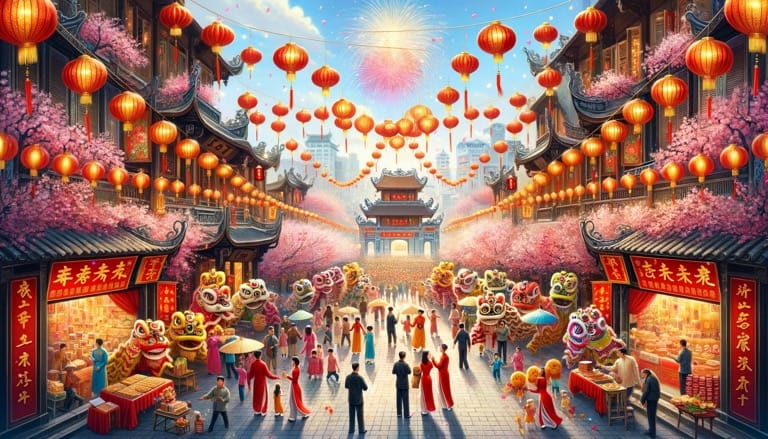The Celebration of Lunar New Year in Vietnam: Traditions, Culture, Customs, and History
The Lunar New Year, known as Tết Nguyên Đán or simply Tết in Vietnam, is the most significant and celebrated holiday in Vietnamese culture. It marks the arrival of spring based on the lunar calendar, a symbol of renewal, family reunion, and respect for ancestors. This festival embodies a rich
The Lunar New Year, known as Tết Nguyên Đán or simply Tết in Vietnam, is the most significant and celebrated holiday in Vietnamese culture. It marks the arrival of spring based on the lunar calendar, a symbol of renewal, family reunion, and respect for ancestors. This festival embodies a rich tapestry of cultural traditions, customs, and historical significances, deeply rooted in the social fabric of Vietnam. This article delves into the multifaceted aspects of Tết, exploring its traditions, cultural practices, customs, and historical background, offering insights into how this celebration is a cornerstone of Vietnamese identity.
Historical Background
Tết's origins can be traced back to ancient agrarian societies in Vietnam, where it was primarily a festival to thank the gods for the arrival of spring, a crucial time for farming. Over centuries, Tết has absorbed influences from Chinese Lunar New Year festivities, due to the historical Chinese domination over Vietnam, integrating these elements with indigenous traditions. Despite these influences, Vietnam has nurtured a distinct celebration that resonates with its national ethos and cultural values.
Cultural Significance
Tết is not just a time for festivity but also a profound cultural expression of Vietnamese values such as family unity, gratitude, and respect for nature and the ancestors. During Tết, the Vietnamese believe that the gods of heaven and earth, along with the ancestors, visit to join in the celebrations, bless the family, and bring good fortune for the new year. This period is a vibrant tableau of cultural rituals, culinary feasts, and communal joy, reflecting a deep bond with the cycles of nature and the lineage of ancestors.
Preparations and Traditions
Preparations for Tết begin well before the actual festivities, symbolizing the purging of the old year's misfortunes and welcoming new energy. Homes are meticulously cleaned, debts are settled, and disputes are resolved, fostering an atmosphere of harmony and renewal. One of the most iconic symbols of Tết is the "Hoa Mai" (Ochna integerrima) in the south or "Hoa Đào" (peach blossom) in the north, which are believed to bring prosperity and ward off evil spirits.
Families also create or buy "Bánh Chưng" or "Bánh Tét", traditional sticky rice cakes filled with mung beans and pork, wrapped in banana leaves. These cakes symbolize the Earth (Bánh Chưng) and the Sky (Bánh Tét), reflecting the ancient Vietnamese cosmology.
Customs and Practices
The first visitor to a home during Tết is considered a harbinger of the year's fortune, a custom known as "xông đất". This visitor is often carefully chosen based on their zodiac compatibility with the host family. Moreover, giving "lì xì", red envelopes containing money, is a practice that not only symbolizes good luck and prosperity but also reinforces social bonds.
Another significant aspect is the ancestral altar, where offerings of food, flowers, and incense are made to honor the ancestors. This practice underlines the Vietnamese belief in filial piety and the continuity between the living and the departed, a testament to the Confucian influence in Vietnamese culture.
Festivities and Celebrations
Tết is marked by an array of festivities that include lion dances, fireworks, folk music, and various traditional games. Streets and homes are lavishly decorated with lanterns, flags, and blossoms, creating a festive atmosphere that envelops the entire country. Public spaces come alive with cultural performances and art exhibitions, showcasing the rich tapestry of Vietnamese heritage and folklore.
Food and Feasting
Food plays a central role in Tết celebrations, with elaborate meals prepared to bring families together. Besides "Bánh Chưng" and "Bánh Tét", dishes such as "Thịt Kho Tàu" (caramelized pork belly), "Gà Luộc" (boiled chicken), and "Xôi Gấc" (red sticky rice) are staples. These dishes are not only culinary delights but also carry symbolic meanings, representing health, prosperity, and unity.
The celebration of Tết in Vietnam is a profound manifestation of the country's cultural identity, encapsulating the values, traditions, and aspirations of the Vietnamese people. It is a time when the past and the present converge, creating a space for reflection, celebration, and hope for the future. As Vietnam continues to evolve, the essence of Tết remains a constant reminder of the nation's rich cultural heritage, its reverence for family, and the cyclic nature of life itself. Through the prism of Tết, one can appreciate the depth and vibrancy of Vietnamese culture, a culture that cherishes harmony, renewal, and the eternal bonds of kinship.





